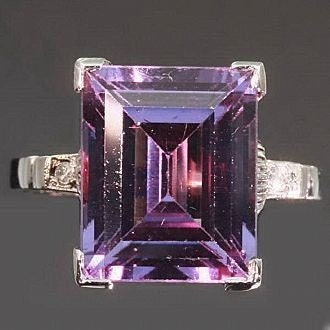Alexandrite, the June birthstone, naturally occurs as a pinkish or purplish gem form of beryllium aluminate (BeAl2O4), specifically Cr+3:BeAl2O4.
Some rare specimens exhibit color change, which means that in natural light they look greenish and in artificial light they look pink or purple.
This color change property is so desirable that people have come up with a range of ways to achieve it from natural and man-made stones.
Pretty much all alexandrite you will see on the market is man-made or at least tampered with.
Let's go through some:
$29,994 natural alexandrite and white gold ring
Natural
You can tell this mainly by its insane price and certificates that come with it. Also inclusions, bright green in natural light, yadda yadda you can't afford it.
$2,250 Platinum and Alexandrite estate ring
Verneuil (aka Flame Fusion aka Czochralski)
This refers to the first process of synthetic gemstone creation, starting in 1902. It involves starting with a real, natural stone (in this case corundum which is the mineral behind rubies and sapphires) and powdering it, adding whatever other minerals you need to achieve your look, and then blasting it with a torch until it forms a globule of new gem, which you can then cut.
With other gems, this process can produce a chemically identical stone and those are called "simulated," but with Alexandrite, corundum is used instead of BeAl2O4 and it should be called "synthetic."
$233 gold and lab created alexandrite ring
Lab Created/Natural or Russian alexandrite
This is the modern version of the process above. Lab-created alexandrite can be pink or purple in daylight and then color changes to a darker purple or blue, so watch out for those, it is a sign they aren't truly natural.
Many of these lab created stones are almost indistinguishable from the naturally mined kind, and are made of exactly the same stuff.
Created stones might have air bubbles or uni-directional streaks. Get out your magnifying glass. Some display color banding (look for stripes).
$299 Green to blue color change chrysoberyl ring
Natural Chrysoberyl
There are other varieties of chrysoberyl that exhibit color change, like from yellow to green or green to brown. They might be sold as alexandrites, but they aren't.
Then we have stuff that is not even remotely related to alexandrite other than being purplish:
Cubic Zirconia
Swarovski crystal
Glass
And I am sure there is some plastic and other crap out there too.
The question you have to ask yourself if you want a piece of alexandrite is: how real is real enough?



I am a big fan of lab-created stuff, personally. It's kind of funny where the line between "fake" and "real" is drawn, because as far as I'm concerned, if the chemical composition is the same then it's real.
ReplyDeleteIt's a really interesting topic to me, gaspode. I think the lines are blurry already and they will get even more blurry in the future when the lab processes become cheaper and the natural extraction comes at a higher environmental and human cost.
ReplyDeleteI tend to agree, though--if it's made of the same stuff and almost impossible to tell apart from the real, it is the same stone.
The other gems treated to mimic the look of alexandrite, though, is where I draw the line. But everyone should decide for themselves.
"the natural extraction comes at a higher environmental and human cost."
ReplyDeleteyup, and if I were ever wavering, that's what would put me over the edge.